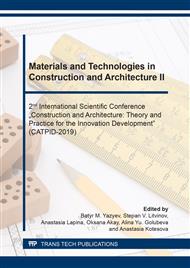p.477
p.482
p.491
p.496
p.505
p.510
p.515
p.521
p.529
Perspectives of the Application for the Nonlinear Deformation Model in the Calculations of Reinforced Concrete Elements
Abstract:
The perspective directions of the calculation method applied application based on the nonlinear deformation model are presented. Some examples of the elements reinforced sections calculation applicability method with flexible, rigid steel reinforcement, composite reinforcement are given as well as the application of this method for the calculation of the uneven distribution of the strength and deformative characteristics of concrete and other damage to reinforced concrete structures; for the gain structure design, including the non-removing load; to assess the stiffness and carrying capacity of the elements with composite sections of various combinations of materials; for the calculation of the effect of repeated, alternating loads. To a large extent, the possibility of a broad application of the nonlinear deformation model is provided by the flexible form of mathematical writing of expressions for determining stiffness characteristics, which are transformed to the requirements of the solved problem.
Info:
Periodical:
Pages:
505-509
Citation:
Online since:
December 2019
Authors:
Price:
Сopyright:
© 2020 Trans Tech Publications Ltd. All Rights Reserved
Share:
Citation:


